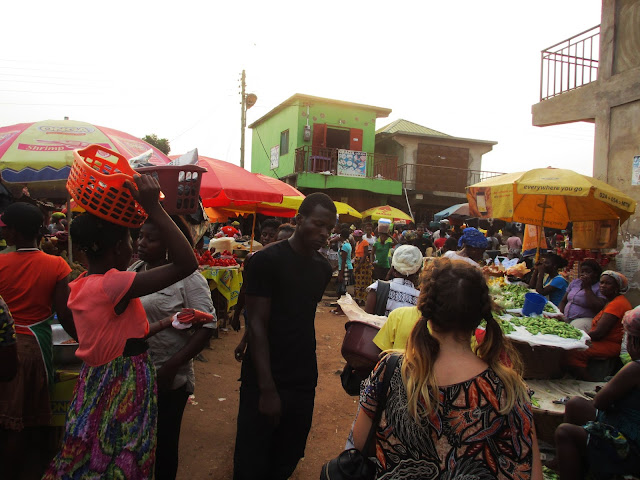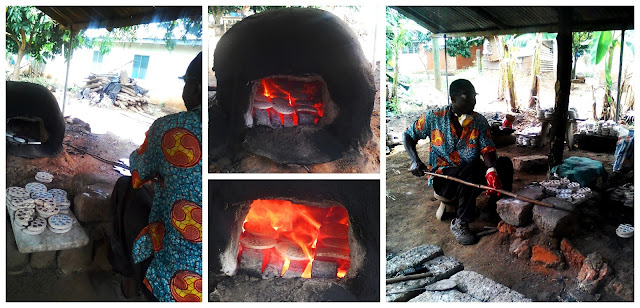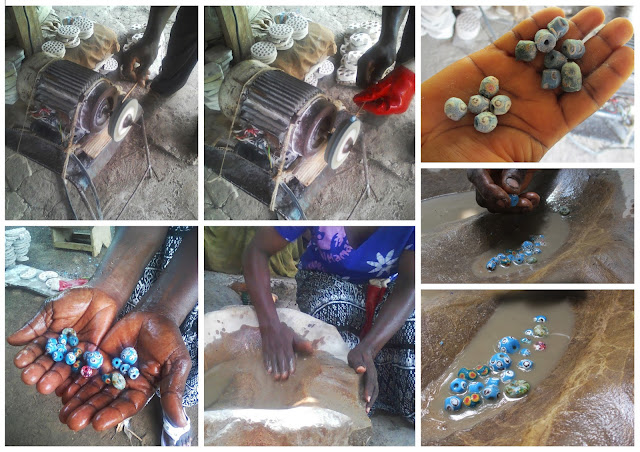Last Wednesday I went on a short trip to Krobo-Odumase to visit the local market which is known for it's amazing traditional, handcrafted bead stalls. The bead market area is open only on Wednesdays and Saturdays but, after doing some research online, I found out that on Saturdays there are a lot of funerals and so sometimes the stalls are empty. We arrived around 2.30pm after setting off from Cape Coast at 7am, travelling firstly to Accra then onwards to Madina where we changed onto a Tro-tro heading towards Somanya.
Upon arrival we had to walk through the bustling Krobo-Odumase market, I had expected the bead market to be in a separate location to the rest of the stalls but it was nestled in the centre in an open brick area, like a small bead island. The surrounding market sold everything from wax print fabric and traditional batik to vegetables, spices, smoked fish and even chicken feet. Everything was packed so tightly together that, to the untrained eye of a tourist, the stalls were almost indistinguishable from each other. At one point we got so lost trying to get back from the bead market that our only point of reference was a woman who kept calling "Jackie Chan" after us...because evidently we look Asian and male...
 |
| Krobo-Odumase market |
The market so much of a sensory assault (not necessarily in a bad way) that I found it extremely hard to process all of the new information my brain was receiving. When there are so many new sensory experiences coming at you from every angle it becomes very hard to decipher which information you need to pay attention to. There are new smells, many of them verging on unpleasant(smoked fish, open sewer, dust), new visual experiences including all of the women carrying an assortment of objects on their heads and all of the colourful garments you are walking past, there are people surrounding you on all sides and cars squeezing past you through impossibly small gaps while young boys with wheelbarrows hurry along next to you. All the while you are being exposed to so much noise; market traders selling their wares, Ghanaian music, car horns,and small children constantly greeting you because of your skin colour.
 |
| A few photos of me shopping for beads and negotiating prices in the market. |
It sounds like I'm complaining with the description I gave above, but I actually absolutely loved it. Bartering with the traders on the price of a string of beads and envisaging what I could turn each of them into. They were so colourful and some of them were so very old, "older than my grandmother" as one trader proudly told us! I ended up getting quite carried away and buying quite a lot .....however I still came away feeling like I didn't quite get enough.
In the future I hope to have my own business, perhaps part of that will involve selling jewellery, I would love to come back to Ghana and visit Krobo-Odumase bead market once again with a bigger spending budget!
Here are the beads I ended up buying:
On the Thursday we had arranged to go to a bead workshop run by Moses and Grace, two bead makers employed by Global Mamas. They were both such lovely, gentle people and seemed to really love what they do- Moses told me he has been making beads for 14 years, making him a true artisan.
Despite the lack of iphone, I have managed to compile enough photos to show you the whole bead making process- YAY!
There are very few adjectives strong enough to describe how amazing watching this process was. It is so artisanal and there are so many complex stages, I also didn't realise how laborious bead making actually is!
 |
| Moses and Grace, their bead kiln and workshop. |
The workshop was located in the most peaceful area, shaded by mango trees and banana palms, there was one bamboo thatched structure housing the kiln and another used for grinding/shaping and smoothing/polishing the beads.
While at the workshop I saw the full extent to which everything in Ghana is recycled and how all raw materials are produced locally- it's so resourceful. I wish we were more like this in the UK, instead of our throwaway society where most things are sent to the dustbin instead of being fixed or up-cycled.
 |
| The glass grinding process, from the gathered glass bottles to the fine glass powder produced at the end. |
Recycled glass bottles are separated by colour and then ground down with a large pestle and mortar type of equipment until they become a fine glass powder. The powder is then sieved to separate the larger pieces from the finer grains, the larger pieces are then re-ground.
I even gave the glass pounding a go and after a few minutes I was extremely sweaty and tired, it is so impressive how Moses manages to do that on a daily basis. I asked him how long he pounds glass each day and he said 4 hrs.... I couldn't even keep it up for 4 minutes!
 |
| The clay molds used to make the beads. |
The beads are made using these clay molds, holes have been carved out of the clay and a small hole indented into the bottom of each hole. Stems from the locally grown Cassava plant are poked into the holes and cut down (with a razor blade attached to a stick) so that they don't rise above the surface level of the clay. These are to create the holes in the glass beads-as the beads are put into the hot kiln the cassava stem burns and disintegrates leaving a hole in the bead.
It's quite an amazing process with minimal wastage. The clay molds are then used until they break, they are then ground down and the clay re-used to make new molds.
The next step is to add the glass to the mold to make the beads. Dye powder is mixed with the fine glass powder to create a coloured glass powder mixture. The powder is then used to fill in the holes of the clay mold and then a feather is used to brush down the mold, ensuring no powder is wasted or left on the exterior of the mold. See what I mean about being resourceful- they used A FEATHER to brush off the excess powder....it's just WOW!
 |
| Adding the dye to colour the glass powder |
After preparing the molds and filling them with glass powder they are ready to put in the kiln.
The kiln is heated by wooden poles and palm trunks inserted into the back which are then pushed further into the oven as they burn. It was so hot around the kiln that it almost made the African weather feel cool.....almost!
 |
| Moses placing the clay molds into the kiln. |
After around 30 minutes the beads were ready to be removed from the kiln, in the absence of a thermometer or any way of telling the exact temperature of the kiln, the bead makers really need to know their craft well to get the timings right. It was amazing to see how the beads had changed colour in the heat, they became so much brighter than the powder had been.
 |
| The final beads |
The beads were dropped into a bucket of cold water to be cleaned and then palm oil was added to make the beads nice and glossy.
 |
| Me trying to poke some of the beads out of the molds and onto the wire string for them to be shipped. |
We also had the opportunity to see how some of the more complicated beads are created and how they are ground down from being a rough almost cube shape to being rounded with smoother edges.
 |
| The bead grinding and polishing process. |
I think my favourite part of the whole process had to be watching the beads being cleaned/polished- they are placed on a big smooth grinding rock that has had its centre smoothed with the constant grinding. Water and sand is added and the beads are repeatedly rolled around until all of the excess hardened glass is removed from the surface of the beads leaving a smooth exterior. The noise the beads make as they are being rolled around in the water was so relaxing.
I managed to use the animoto website once again to marge all of my photos and video clips into a video showing the krobo bead market and then the bead workshop. As with the batik video, the animoto watermark is still on the link but this will be removed once I commit to upgrading my subscription!
I hope you've all enjoyed watching this video/reading this post as much as I enjoyed taking part in the workshop! :)
P.S The song in the video is one of my new favourites! It's a Ghanaian dancehall artist called Shatta Wale who I will hopefully be seeing perfom this Saturday ;)



1 comment:
This is an amazing content. Very extensive. Gosh a lot of work went into this research. I thoroughly enjoyed reading this. I felt l was there with you. You are a storyteller. Fantastic work. Thank you.
Post a Comment